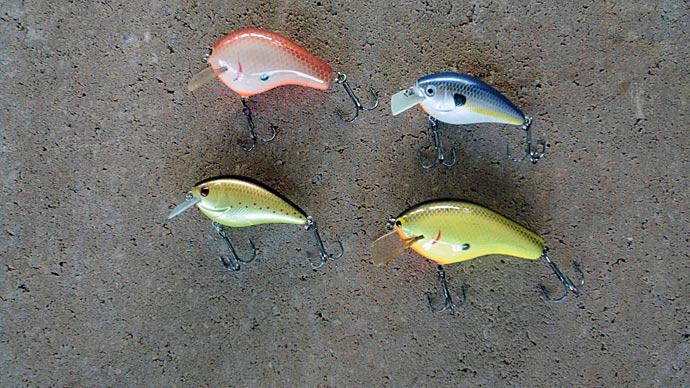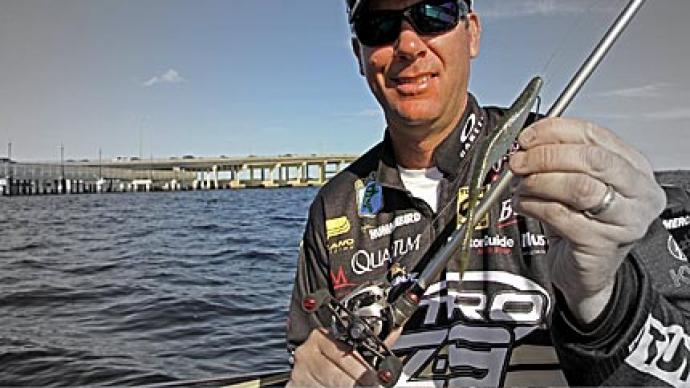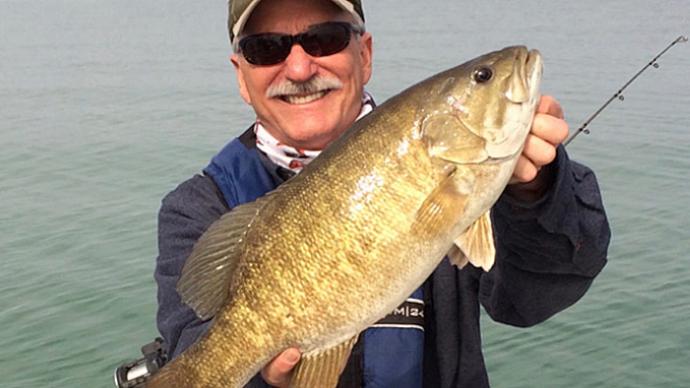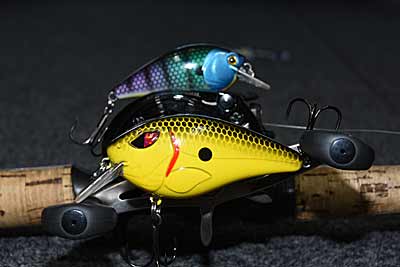
Fall time is a period that I look forward to fishing. Days are getting shorter, and bass are grouping up as they prepare for the upcoming season's change. This is when I like to pull out my square bills and get to work. This article will break down late-season square bill fishing for bass, what you'll need to look for, how to adapt to the changing conditions, and how the bass will react. So, let’s get square.
General Fall Bass Movements
Depending on where you live in the country, bass are bass and will do the same thing up North as they do down South, but it may just be a month or two later when you look at the calendar. Coming off summer, you have a bass population that occupies shallow water haunts and weed flats and a deepwater population of bass.
The deepwater population will be the first to move shallower of these groups. This is not a choice that they make. It's triggered by their food source leaving their deepwater summer haunts. Two main factors drive this food movement: the baitfish’s food source is moving shallower, and they will follow, and two, it may be their spawning season, thus facilitating this move towards the shallows.

Fall mimics the same thing in the spring season when bass occupy these same waters around the spawning season. Square bills are an excellent choice to fish during both seasons.
Square bills allow you to cover water quickly, looking for bass. The more contact you can make with the cover and break it free on its way again, the more bites you'll trigger throughout the fall season with square bills.
Square Bills Makeup
Not all square bills are created equal. First, this square bill category of baits is big and has many differences. When it comes to stocking square bills in your boat, make sure that you carry a variety of baits in your box. The biggest reason a square bill is such a fishable bait is its deflection characteristics. I often get a square bill through the cover cleanly when I can't get other baits through that same cover without getting it hung up.
Wood vs. Plastic
Wood vs. plastics is a question raised all the time. At first look, I carry both because they have unique niches and fishability.
Wood Square Bills
Wood square bills excel in getting through cover because they float back up out of the cover when you stop them. When targeting cover on the bank, I'll tie on a wood square bill and cast to the middle of the laydown because I know I'll get this bait back. Make your cast and (now this is key) WORK your square bill out of the tree. If you start cranking, there is a good chance that you'll get your bait hung, and if you try to yank it out, you'll get it hung for sure. But if you stop reeling and move your rod to get the square bill over the limb, you can reel again when you get it on the other side. If you feel the bait starting to get hung, stop reeling, give the line slack and let the bait float back out of the cover so you can start your retrieve again.

Many wood square bills don't come equipped with rattles and will have to rely on the bait's action to generate bites. Wood square bills also are a great to fish in clear water conditions. These baits are not loud but create enough sound through bait movement to be found and attract bites.
Plastic Square Bills
Characteristics of plastic square bills are different than wood. Most, if not all, of these baits come equipped with rattles. Plastic square bills are excellent choices to use when bass bury up in the cover, and you have to call them out to get your bait, or when you're fishing in dirty water conditions where bass will have to use sound to help them find their food. Plastic square bills often dive a foot or two deeper, so keep this in mind when targeting a range. As a general rule of thumb, wood squares will work a depth range of 2-4ft incredibly well, and plastic will work in the range of 2-6ft in most cases. Yes, you'll have a few baits that push this range deeper so pay attention when buying baits to ensure they can reach the depth range you're trying to reach.
Colors – Match The Forage In Your Waters
Just pick up any crankbait catalog and look at the square bill colors selections. You have far too many to pick from. Now that company would love to buy two of each color, but that is not feasible. So to start, pick colors that match the forage that swims in your waters. Bluegills are the number one forage in my part of the country, with crawfish being a close second in my waters. Shad may be the top producer in other parts of the county, so match your selection to your waters.
Also, carry noticeable colors (bright colors) in your collection. For example, bluegill with chartreuse or orange highlight. Colors that are bright and stand out and get noticed. This will often be the difference between getting a strike and a bait that doesn't get their attention.
Finer Square Bill Points
Hooks – Make sure that your hooks are sharp. This is something that many fishermen don't regularly consider unless they start to lose fish. Make sure your hook points are sharp at the start of your day. If you're fishing in rocks, hooks will get dull quickly from the constant contact with the rocks. Take the time a few times a day to check your hooks.
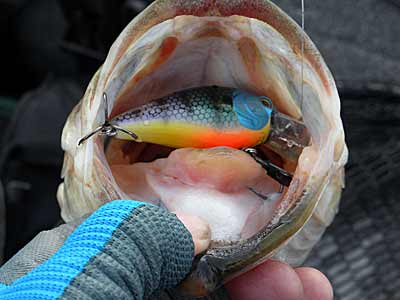
Snaps – Using a snap will do two things for you. One, it will make changing your square bills quicker, and second, it will give your bait more action. Don't get locked into one bait unless you're catching bass. Keep changing baits until you find what the bass want that day. Using a snap will help you change baits faster in your search.
The more your square bill can implement when it comes to action, the more attraction it will create. Using a snap will give your bait more freedom of movement, creating more strikes in the process.
Some square bills are sensitive to the split ring on the bait. So when first trying the bait, if it's running to one side or the other, change the split ring's position before adjusting the eye on the bill.
Size Matters – The size of your square bill matters. When trying to match what the forage is in your waters during the fall season, you'll get more bites using a smaller-sized bait because that matches the size of this year’s forage. When faced with fishing in dirty water conditions, you can often get by with a bigger bait, but in clear water conditions, this may cost you bites. Let the bass tell you what size square bill they want.
Also, fish the sunny side of the lake in the morning. The sun will boost the temperatures up a degree or two, triggering the bass to eat early in the day instead of midday in some areas. Forage will also be drawn to this side of the lake to take advantage of the warmer mornings.
Equipment Breakdown
Much of this will be a personal preference for equipment, but I will suggest how I fish square bills. If I'm fishing around and targeting laydowns or shore features, I'll fish a Denali Attax 7’ (AC7002GC) glass cranking rod. This rod allows me to hit targets that I'm looking to work. I will team a Lew’s BB-1 5.1:1 gear ratio reel spooled with Sunline Crank FC in 12lb to 14lb. I will determine line size according to the cover that I'm fishing.
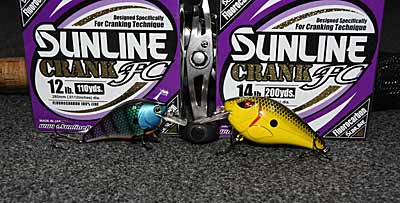
If I target open water areas, I may upsize to a Denali Attax 7’4” or 7’10” cranking rod. The added rod length allows me to make longer casts and pick up line faster. This will help me get better hook sets at the end of a long cast. I will also use the same reel and line choice for this category.
I use several different ones to trigger strikes when it comes to retrieves. Suppose I can get away with a simple cast and retrieve during my day; that is what I'll use. My goal on every cast is to get my bait down and have it hit the cover on its way back to the boat.
I will also throw in a retrieve that has me hitting targets while using a stop and go. Reel your bait down, rip it off the cover, and let it sit for a 1-1000, 2-1000, then start to reel if you don't get a strike. Sometimes the strike will come on the pause, and other times it will happen when you start to move the bait again. Let the bass tell you what they want, as this may change today. I have even had cases where their preference changed in the middle of the day because of changing sun and cloud conditions.
I hope these square bill tips help you put more bass in your boat this fall. Nothing is set in stone so keep changing baits and actions until you start to trigger bites, then try to work off what you have found. The best advice that I can give you is to cover water, and the more contact you can make with your square bill, the more bites you'll trigger along the way.
BassResource may receive a portion of revenues if you purchase using a link above.


